NVIDIA 680i: The Best Core 2 Chipset?
by Gary Key & Wesley Fink on November 8, 2006 4:45 AM EST- Posted in
- CPUs
NVIDIA Control Panel & nTune 5
One of most interesting features at the nForce 500 launch was the revamped control panel and nTune 5.0 performance applications. The Control Panel and nTune have undergone some fine tuning the past few months with version 5.05 launching for the nForce 600 and GeForce 8800 series of products shortly. NVIDIA has combined all of their various program applets into an integrated control panel to provide a common user interface. We found that this common interface makes it easier for a user to control the various functions of the board and video (NVIDIA based) from a central access point.
The new control panel offers configuration sections for 3D Settings for NVIDIA GPUs, Display settings, Networking options, Performance, System Stability testing, Storage, and Video/Television settings. The information contained in each section will already be familiar to those with nForce4 or nForce 500 boards but will include a few extended configuration options for the nForce 600 and GeForce 8800 products.
One noteworthy change with the GeForce 8800 series is that Coolbits no longer works for overclocking the GPU. The overclocking panel will still be visible in the legacy control panel but it will tell you to download nTune in order to overclock your GPU. The new GPU overclocking utility works in the same manner but is now integrated into the revised Control Panel.
One of the more interesting features for us is the Adjust Motherboard Settings application. We found the ability to dynamically write a significant number of performance settings directly to the BIOS without requiring a reboot a very quick and easy way to test or set overclocking options without exiting Windows. There are several third party applications that perform this same function but we believe the official support within the BIOS and nTune software gives it a significant advantage over the other solutions. The settings can be saved in a profile that can be loaded within Windows without having to reset the BIOS for individualized situations where settings for games might differ from those for audio/video playback. The system also allows for automatic or direct fan control on supported fan headers.
The Dynamic BIOS Access section offers the ability to change BIOS setting in five different categories that will take effect on reboot. The two sections not displayed are for power management and peripheral settings.
If you are not the type to enter the BIOS and tune your system or set it up for overclocking then NVIDIA offers an application that can do it for you based on your combination of components. We found the Coarse Tuning option would generally set up our system for a 6%~9% overclock of the FSB and memory along with a 3%~5% overclock on the GPU. The Fine Tuning option resulted in an 8%~15% overclock of the FSB and memory while the GPU usually increased 5%~8%.

NVIDIA also includes a System Information utility along with a Windows based monitoring application. Overall, the polished look, feel, and operation of the new control panel along with the performance improvements offered in nTune 5.05 has raised the bar once again for user enhancements offered by the core logic suppliers.
One of most interesting features at the nForce 500 launch was the revamped control panel and nTune 5.0 performance applications. The Control Panel and nTune have undergone some fine tuning the past few months with version 5.05 launching for the nForce 600 and GeForce 8800 series of products shortly. NVIDIA has combined all of their various program applets into an integrated control panel to provide a common user interface. We found that this common interface makes it easier for a user to control the various functions of the board and video (NVIDIA based) from a central access point.
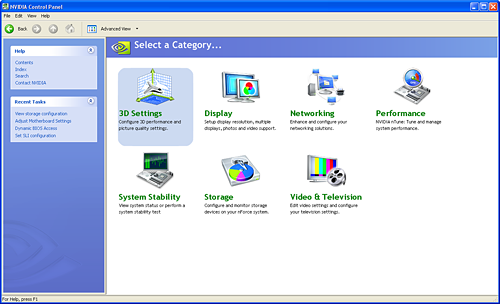 |
| Click to enlarge |
The new control panel offers configuration sections for 3D Settings for NVIDIA GPUs, Display settings, Networking options, Performance, System Stability testing, Storage, and Video/Television settings. The information contained in each section will already be familiar to those with nForce4 or nForce 500 boards but will include a few extended configuration options for the nForce 600 and GeForce 8800 products.
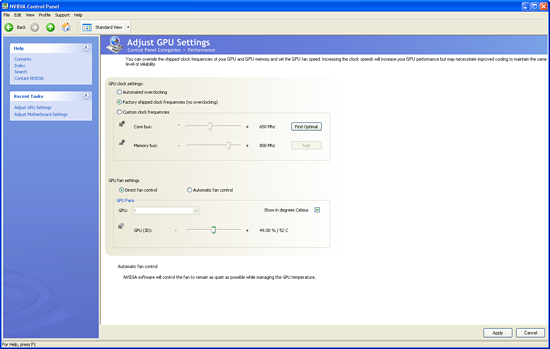 |
| Click to enlarge |
One noteworthy change with the GeForce 8800 series is that Coolbits no longer works for overclocking the GPU. The overclocking panel will still be visible in the legacy control panel but it will tell you to download nTune in order to overclock your GPU. The new GPU overclocking utility works in the same manner but is now integrated into the revised Control Panel.
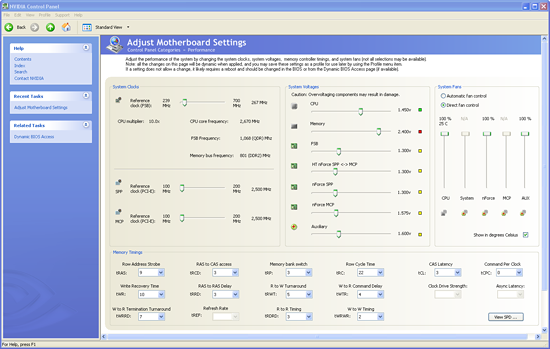 |
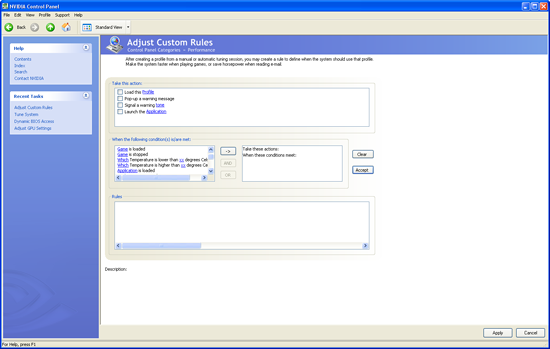 |
| Click to enlarge |
One of the more interesting features for us is the Adjust Motherboard Settings application. We found the ability to dynamically write a significant number of performance settings directly to the BIOS without requiring a reboot a very quick and easy way to test or set overclocking options without exiting Windows. There are several third party applications that perform this same function but we believe the official support within the BIOS and nTune software gives it a significant advantage over the other solutions. The settings can be saved in a profile that can be loaded within Windows without having to reset the BIOS for individualized situations where settings for games might differ from those for audio/video playback. The system also allows for automatic or direct fan control on supported fan headers.
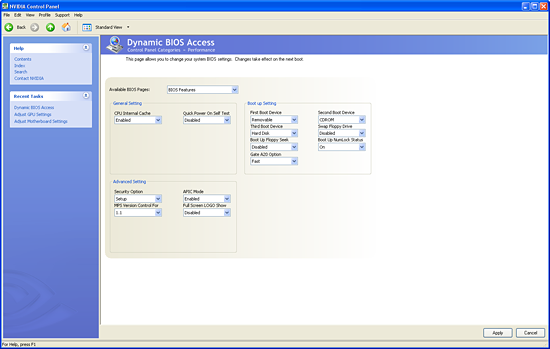 |
 |
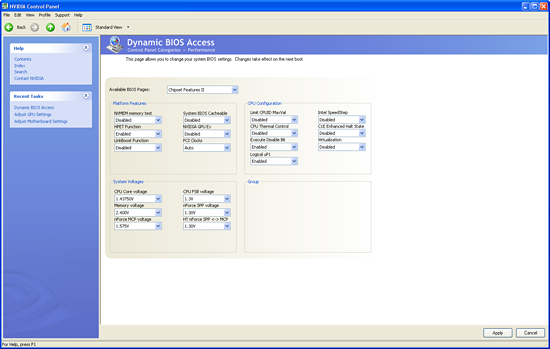 |
| Click to enlarge |
The Dynamic BIOS Access section offers the ability to change BIOS setting in five different categories that will take effect on reboot. The two sections not displayed are for power management and peripheral settings.
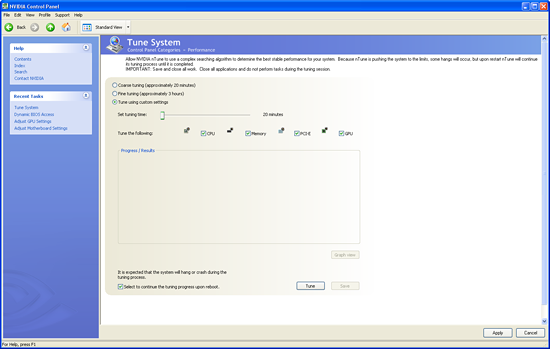 |
| Click to enlarge |
If you are not the type to enter the BIOS and tune your system or set it up for overclocking then NVIDIA offers an application that can do it for you based on your combination of components. We found the Coarse Tuning option would generally set up our system for a 6%~9% overclock of the FSB and memory along with a 3%~5% overclock on the GPU. The Fine Tuning option resulted in an 8%~15% overclock of the FSB and memory while the GPU usually increased 5%~8%.
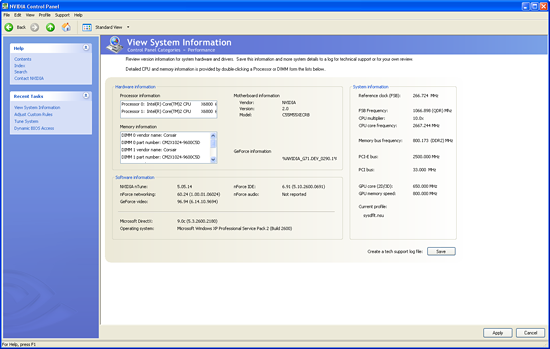 |
| Click to enlarge |

NVIDIA also includes a System Information utility along with a Windows based monitoring application. Overall, the polished look, feel, and operation of the new control panel along with the performance improvements offered in nTune 5.05 has raised the bar once again for user enhancements offered by the core logic suppliers.










60 Comments
View All Comments
yyrkoon - Thursday, November 9, 2006 - link
From my little experience with an Asrock board that can use this program, it WILL adjust clock frequency on the fly, however I think that voltage changes need be done only by rebooting. Reguardless whether I'm remembering correctly, I'm fairly certain atleast one possible change needs to be done during, or after a reboot, could be thinking of clock multiplier maybe ?Pirks - Thursday, November 9, 2006 - link
that sucks. guess I'll have to wait till nVidia makes 100% nonreboot-OC mobo, or on-the-fly-OC mobo where you just click a couple of buttons in Windows and voila - your machine turns from quiet office machine to a Crysis fireball, and vice versa - I can dream, can't I? ;)ssiu - Wednesday, November 8, 2006 - link
Since NVIDIA claims the 680i has better FSB overclock than the 650i's, and the 680i results are on par with the mainstream P965's, I am afraid that the 650i's would be significantly worse than the DS3s/P5Bs. In other words, I am afraid that the 650i's are not really a new competitive option for budget/mainstream overclockers.yyrkoon - Wednesday, November 8, 2006 - link
I dont think any true enthusiast is going to be buying a mid range board(chipset) to begin with. If the Intel numbering shceme is anything like the AM2 numbering scheme, the 650i will probably have less availible PCI-E lanes as well, and would be a major factor in my personal decission in buying any such hardware, and I know I'm not alone ;)Jedi2155 - Wednesday, November 8, 2006 - link
I don't think your definition of enthusiast is wholly correct but rather the Manufacturer idea of enthusiasist. I personally think many enthusiasists do indeed have a limited budget, and after seeing the pricing of Asus 680i board, I think mid-range is the way to go...hoping for a cheap < $250 680i board >_>.yyrkoon - Wednesday, November 8, 2006 - link
Yeah, He wasnt talking about true enthusiasts though, I realize this after re-reading his post.One a side note, that if my board brand of choice suddenly went away (ABIT), I would seriously consider buying a Gigabyte board, but the DS3 doesnt seem to be making a lot of people happy in the stability category. What I'm trying to say here, is that perhaps the board MAY not OC as well, but that according to what I've read (reviews, forum posts, and A LOT of newegg user reviews), it couldnt do much worse than the Gigabyte board in this area.
The second question I'd be asking myself, is WHO THE HELL is EVGA . . . we all know they make Video cards (probably the best for customer support for nVidia products).
I'm definately interrested in the 680i chipset, but i think my brand of choice for MANY years now would remain the same, and that I'll be sticking with ABIT :)
Gary Key - Wednesday, November 8, 2006 - link
1. The reference board is designed and engineered by NVIDIA. Foxconn manufactures the boards for the "launch" partners that include BFG and others. Asus, Abit, DFI, Gigabyte, and others will have their custom designed boards out in a few weeks.2. The Abit board is very interesting, here is pic of it - http://img474.imageshack.us/img474/2044/in932xmaxy...">Abit 680i - ;)
yyrkoon - Thursday, November 9, 2006 - link
Didnt even know there was one this close to release gary, lol thanks for the link. Judging by the 5 SATAII connectors, previously released ABIT boards, and what LOOKS like an eSATA connector on the back panel, I suppose this board will support eSATA, and possibly a SATA PM ?Stele - Friday, November 10, 2006 - link
That Abit 680i board looks very interesting indeed... if nothing else because it looks like it sports a digital PWM power supply circuitry similar to that used by DFI in the latter's LANParty UT NF590 SLI-M2R motherboard (the Pulse PA1315NL coupled inductor array is a dead giveaway, as it is designed for use only with Volterra's VT11x5M digital PWM circuitry).Unfortunately more information on such circuitry is proving very difficult to find (Volterra themselves restrict their product details and datasheets to design partners only) ... it'd be great to know how such a power circuit compares in performance and capabilities over the traditional PWM-MOSFET-based ones.
Curiously, the Abit 680i seems to have dropped the AudioMax daughter board.
yyrkoon, I'm guessing the 5th SATA II and the eSATA port are there courtesy of an SiI3132 controller - which is likely the little square IC under the upper heatpipe, just beside the audio connector block. As such, the usual capabilities and features of the said IC would apply, I think :)
yyrkoon - Wednesday, November 8, 2006 - link
I'd just like ot point out that DualNet technology is NOT true NIC Teaming, or rather Link agrregation(802.11a/d I think).When I first heard about DualNet I was extremely excited, since I had been doing TONS of research on NIC bonding etc, but after doing some homework, I found that DuelNet only supports out going packets. It was my hope that you could link two of these boards via a regular GbE switch, and get instant 2GbE connections, but this is not the case(unless they've recently redone DualNet).
Now to the question: Since SATA port Multiplier HBAs require a specific SIL chip(s) on the device they communicate with (to give full speeds of a true RAID), what are the chances that nVidia boards will work with these devices ?
In the past, I've seen two AM2 boards that have a built in SIL chip with eSATA connectors on the board back panel (ABIT, and Asus), but onboard SIL 'chipsets' seem to be rather limited(as in only supporting PM support on two SATA connections). I'd personally REALLY like to see this technology standardized, so it doesnt matter WHAT SATA controller chipset you're using. I also think that once nVidia realizes that PM support onboard is a major plus, and once they implement it, they COULD be taken seriously by many Intel fans.
Also, some Intel chipset fans believe that Intel chipsets are best for a rock solid system (for the record, I'm not one of these people), I guess we'll see if nVidia will change thier minds.